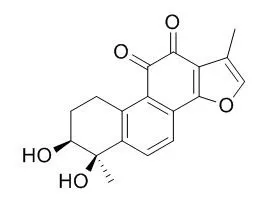| In vitro: |
| Bioorganic & Medicinal Chemistry Letters, 2014, 24(11):2486-2492. | | Biological evaluation of tanshindiols as EZH2 histone methyltransferase inhibitors.[Reference: WebLink] | EZH2 is the core subunit of Polycomb repressive complex 2 catalyzing the methylation of histone H3 lysine-27 and closely involved in tumorigenesis.
METHODS AND RESULTS:
To discover small molecule inhibitors for EZH2 methyltransferase activity, we performed an inhibitor screen with catalytically active EZH2 protein complex and identified tanshindiols as EZH2 inhibitors. Tanshindiol B and Tanshindiol C potently inhibited the methyltransferase activity in in vitro enzymatic assay with IC50 values of 0.52 μM and 0.55 μM, respectively. Tanshindiol C exhibited growth inhibition of several cancer cells including Pfeiffer cell line, a diffuse large B cell lymphoma harboring EZH2 A677G activating mutation. Tanshindiol treatment in Pfeiffer cells significantly decreased the tri-methylated form of histone H3 lysine-27, a substrate of EZH2, as revealed by Western blot analysis and histone methylation ELISA. Based on enzyme kinetics and docking studies, we propose that tanshindiol-mediated inhibition of EZH2 activity is competitive for the substrate S-adenosylmethionine.
CONCLUSIONS:
Taken together, our findings strongly suggest that tanshindiols possess a unique anti-cancer activity whose mechanism involves the inhibition of EZH2 activity and would provide chemically valuable information for designing a new class of potent EZH2 inhibitors. | | Chinese Traditional Patent Medicine, 2014, 36(6):1146-1150. | | Tanshindiol B from Salvia przewalskii inhibits angiogenic activity.[Reference: WebLink] | To study the effect of Tanshindiol B from Salvia przewalskii Maxim. on angiogenic activity.
CONCLUSIONS:
Tanshindiol B was isolated from acetonic extract of S. przewalskii and purified by the silica gel column and Sephadex LH-20 column chromatography. MTT method was employed to explore the effect of Tanshindiol B on the migration and the expression of human umbilical vein endothelial cells(HUVEC) and to measure the vascular endothelial growth factor(VEGF) level. The chicken chorioallantoic membrane(CAM) model was used for in vivo inhibition of angiogenic activity. Tanshindiol B could inhibit the proliferation and migration of HUVEC,angiogenesis on CAM,and the secrete of VEGF in a dose-dependent manner.
CONCLUSIONS:
Tanshindiol B possesses the anti-angiogenic activity,so it can be a promising candidate for angiogenesis inhibitors. |
|






 Cell. 2018 Jan 11;172(1-2):249-261.e12. doi: 10.1016/j.cell.2017.12.019.IF=36.216(2019)
Cell. 2018 Jan 11;172(1-2):249-261.e12. doi: 10.1016/j.cell.2017.12.019.IF=36.216(2019) Cell Metab. 2020 Mar 3;31(3):534-548.e5. doi: 10.1016/j.cmet.2020.01.002.IF=22.415(2019)
Cell Metab. 2020 Mar 3;31(3):534-548.e5. doi: 10.1016/j.cmet.2020.01.002.IF=22.415(2019) Mol Cell. 2017 Nov 16;68(4):673-685.e6. doi: 10.1016/j.molcel.2017.10.022.IF=14.548(2019)
Mol Cell. 2017 Nov 16;68(4):673-685.e6. doi: 10.1016/j.molcel.2017.10.022.IF=14.548(2019)